ASUS ROG Rampage Formula: Why we were wrong about the Intel X48
by Kris Boughton on January 25, 2008 4:30 AM EST- Posted in
- Motherboards
BIOS Screenshots and Interesting Settings
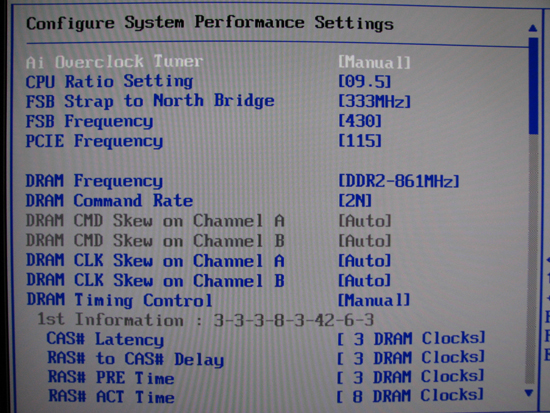
ASUS boards are known for their high level of customization and the Rampage Formula is no exception. The main menu that provides a majority of the options normally associated with overclocking is renamed "Extreme Tweaker", which we feel is entirely appropriate. Users can adjust everything from here, from bus speeds to voltages and memory timings to MCH parameters. Although a few options with indeterminate purposes still exist (for example, "Ai Clock Twister"), for the most part ASUS has done an excellent job in clearly labeling what each setting does.

The ASUS Rampage Formula comes with official FSB1600 support, a feature attached to the use of the upcoming X48 chipset release. Those that want to use the next Intel Core 2 Extreme, the QX9770, will need to buy a board built around X48 if they want a platform validated for 400MHz FSB operation. We found the Rampage required no additional MCH voltage when running at this FSB setting.
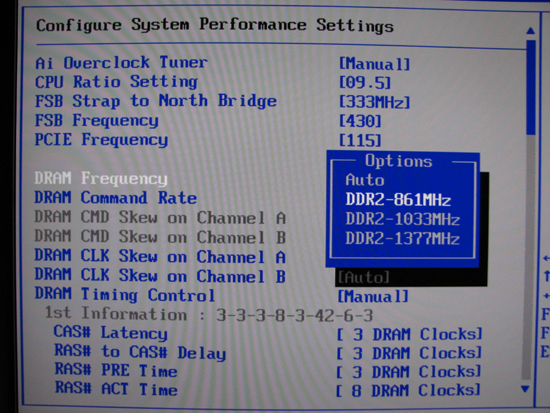
The standard compliment of DDR2 dividers is included in the Rampage Formula's BIOS. We will go into more detail about these later in the review. In any case, even with the fastest DDR2 available, we are not left wanting when it comes to options for pushing our memory.
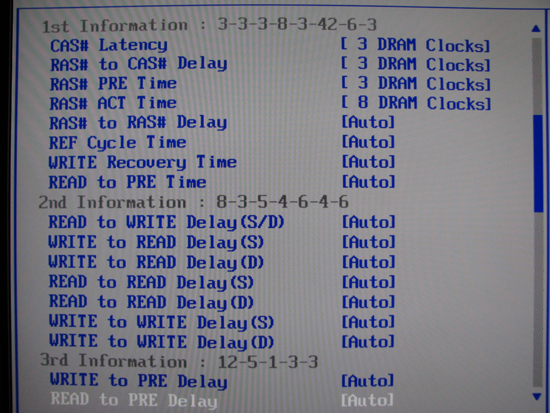
The BIOS includes adjustment options for all primary memory timings - 20 in all. Most of the time a majority of these can be set to "Auto" - ASUS' tuning is already quite good. However, experienced users and memory experts alike will enjoy the expansive level of control allowed.

Here we can get a good look at what we consider the most significant change to the standard ASUS BIOS offering in years. "Common Performance Level", more correctly known as MCH Read Delay (tRD), allows the user to specifically establish a desired value, something that was not entirely possible in the past. Earlier versions of "Ai Transaction Booster" only allowed the user to apply an offset, which made controlling tRD difficult when the base value was unknown.
Additionally, each FSB bus cycle "phase" for each channel can be further manipulated. "CHA" and "CHB" refer to the two independent memory channels in a dual-channel memory configuration. Installing only one memory DIMM, or certain combinations of mismatched memory module pairings across all four expansion slots, results in the motherboard defaulting to single-channel operation; otherwise there are two memory channels in operation, which enhances overall system performance. The number of phases per channel depends on the memory divider in use (each channel will always have the same number of channels though) - a 3:2 memory divider has two phases, 4:3 has three, and 8:5 has five, for example. We will explore the theory behind this truth shortly.
Setting a single channel/phase "Pull-In" to enabled has the effect of lowering that particular phase's associated tRD value to one below the Common Performance Level (the "base" tRD). Leaving the setting disabled leaves the phase unadjusted, in which case it is the same as the base tRD. Much like memory timings, lower tRD values bring greater performance. As we will see, these settings primarily allow users to squeeze out any unclaimed performance benefit possible with the current tRD when the next "lower" Common Performance Level is unachievable. Do not feel as though you need to understand what all of this means right now, as we will cover all of this and much more in excruciating detail soon enough.
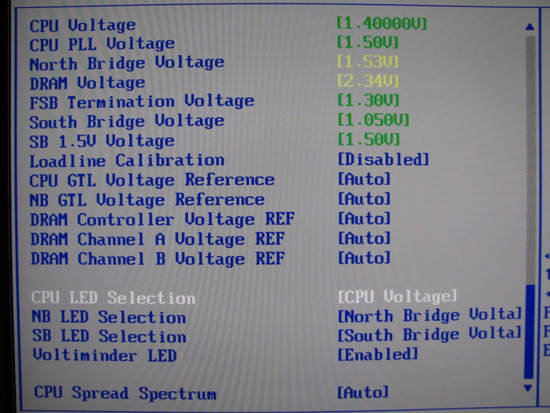
With no less than seven onboard voltage adjustments, the Rampage Formula is a tweaker's dream come true. Because ASUS motherboards do make a habit of "adjusting" some of these values automatically at times, we recommend you manually set all voltages to the bottom of their ranges unless otherwise required. This best practice just makes good sense and ensures nothing receives more voltage than intended by the user. Again, we must also strongly caution against the use of "Loadline Calibration." We recommend you leave this option disabled, especially when installing a 45nm CPU.
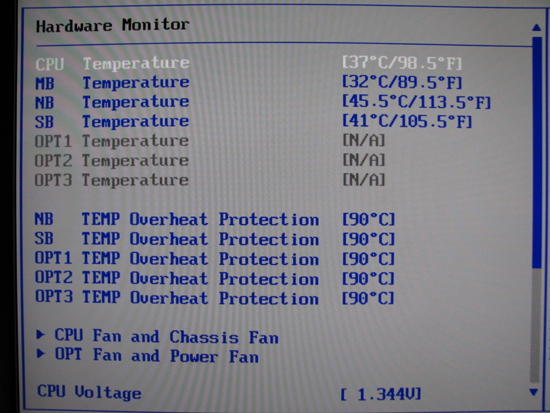

ASUS' implementation of their in-BIOS hardware monitor is extremely informative. You can simultaneously check temperatures for the CPU, motherboard (PWM), Northbridge (NB), and Southbridge (SB) as well as quickly review the effect that prior voltage adjustments had on actual voltage levels. Although we found most reported voltages were fairly accurate, obtaining the most precise readings possible still requires the use of a digital multimeter (DMM).
Regarding voltages, we found two concerns worth mentioning. Firstly, the reported CPU PLL voltage appears to be non-functional as it always reads the same, regardless of setting. Second, like many other ASUS offerings the motherboard consistently overvolts the memory by 0.08 ~ 0.10V. We do not see any real problem with this, as long as the user is aware it's happening.










73 Comments
View All Comments
dallas - Monday, March 24, 2008 - link
I was wondering how this chipset and Windows Vista 64-bit handles IRQ ? I have a Creative X-fi and it has had a lot of problems with PCI-latency and shared IRQ. According to the manual PCI slot 2 is the only one of the two that does not share IRQ with the graphic cards. Do you guys have any experience of this ?Second question is related also to IRQ. I have a Razer Deathadder mouse which I use at 1000Hz polling rate and it seems to cause quite a bit CPU-usage (average of 10% with AMD64 3500+ when moving mouse at desktop without overlapping anything). I guess it would be ideal to connect it to a USB-port not sharing any IRQ. Rampage Formula has 12 USB-ports total, but reading the manual it says there is USB controllers 1 to 6 and USB 2.0 controllers 1 and 2. How do I relate these figures to the actual layout of the board ? USB controllers 2 and 5 are the only ones not sharing IRQ.
http://dlsvr01.asus.com/pub/ASUS/mb/socket775/Ramp...">http://dlsvr01.asus.com/pub/ASUS/mb/soc...rmula/Ra...
Thanks
nitemareglitch - Friday, March 7, 2008 - link
My older DFI nForce 4 board had fully adjustable tRd among other things. Asus taking a play from their book?rge - Monday, February 18, 2008 - link
Granted I am using gigabyte p35 dq6 board, but I thought loadline simply was a sensor adjustment? Anyone know what is meant by induced power instabilities? measured by?I thought (and may well be wrong) that with loadline disabled, if I choose 1.25v bios as vcore, idle would be 1.23 volts (Voffset), load (dual core) would be 1.22v (Vdroop), when load stops, overshoot to 1.25v before decreasing back to 1.23 idle. Thus when you are choosing 1.25 volts in bios, you are choosing max volts ie, overshoot max, and not idle volts.
I thought loadline was simply a ~.02v sensor calibration, so when enabled, and you choose 1.25 volts in bios, you are then choosing the idle volts (instead of overshoot max) and thus it idles at 1.25V. During load you still see vdroop to 1.24v, and overshoots to 1.27v.
In other words no difference between loadline enabled 1.23v and loadline disabled 1.25v, just personal preference of making bios vcore set idle volts or max overshoot volts.
If I am wrong can someone please inform me what loadline is, and what is meant by power instabilities...mean ?greater fluctuations in volts or what?
Nickel020 - Saturday, February 16, 2008 - link
Firstly, great article! Got me a long way in increasing my memory speed and understanding the underlying factors.What I don't understand though is why the X48 is better than the X38. I already have the option to change tRD on my Gigabyte P35 DQ6, and I'm getting much better memory perfromance after manually setting it to 6.
As I see it, the option to adjust tRD is only a BIOS issue and it can be done on P35 and X38, so how does this make the X48 a better chipset?
kjboughton - Sunday, February 17, 2008 - link
The difference comes in the voltages required to run equivalent speeds/tRD settings. In fact, the X48 board are capable of running stable at much higher speeds, using tigher MCH Read Delay (tRD) values at lower voltages. More to come soon...Holmer - Monday, February 18, 2008 - link
Thanks for an excellent article.I would just love to know how well the Rampage formula handles overclocking with 4x1 GB RAM? How large is the performance hit as compared to 2x2 GB and can it handle 1200 MHz (with two 2x1 GB kits rated at this speed).
Roughly when can we expect the loon awaited X48 roundup?
Thanks a lot on beforehand.
Holmer - Friday, February 22, 2008 - link
Another question: Is is possible to manually set tRFC > 42 in BIOS? If yes what is the maximun value of tRFC?I would be very grateful for an answer.
The Ghost - Saturday, February 2, 2008 - link
With 400Mhz, tRD of 4, CL of 4 and 3:2 ratio I get this:1,334 > 1,333
Is that enough to post or is 0,001 to little to "allowed" ?
Vikendios - Wednesday, January 30, 2008 - link
It's all very fine, but as long as ATI/AMD GPU's are outclassed by Nvidia's, the gamer scene which drives the $300+ motherboard business has little interest in non-Nvidia-SLI solutions. It's bizarre that Intel focuses on chipsets that can apparently only handle well (correct me if I'm wrong) their arch-competitors AMD's GPU's in (Crossfire) arrays.Intel should hurry to develop competitors to 790i that are really neutral as to which twinned or tripled video cards are used.
Gary Key - Wednesday, January 30, 2008 - link
The last time I tested it, X38 ran SLI faster than 680i. The problem is not the chipset, it is simply a decision by NVIDIA (and/or Intel) not to "officially" license SLI on the Intel chipset platforms, except for the upcoming Skulltrail board.This whole SLI/Crossfire debate has gone on long enough, the technologies accomplish the same purpose (are practically identical from a technological viewpoint) and setting up a board/BIOS to run either is actually very easy. CF runs just fine on the NV680i/780i and SLI runs just fine on the 975X/X38/X48 if driver support is present and the proper switches are enabled in the BIOS. Personally, I would like to have the ability to run (unhindered) AMD or NVIDIA GPUs in multi-GPU configurations on either chipset platform. I just wish they would let the market determine the best multi-GPU solution, but that is pie in the sky thinking. ;)